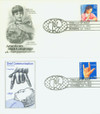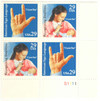
# 2783-84 - 1993 29c American Sign Language
U.S. #2783-84
1993 American Sign Language
- Brings awareness to the deaf and hard-of-hearing community as well as one of the ways they communicate – American Sign Language
- One of two stamps in the American Sign Language set
- Only the second time in 12 years the USPS issued a se-tenant pair of stamps
- Issue date moved from August to September to coincide with Deaf Awareness week
Stamp Category: Commemorative
Set: American Sign Language
Value: 29¢, First Class Mail Rate
First Day of Issue: September 20, 1993
First Day City: Burbank, California
Quantity Issued: 83,680,000
Printed by: Stamp Venturers (printed in Richmond, Virginia, perforated in Milwaukee, Wisconsin)
Printing Method: Photogravure (webfed gravure press)
Format: Pane of 20 (square, 4 across, 5 down)
Perforations: 11.6 (sheetfed stroke perforator)
Tagging: Prephosphored paper
Why the stamps were issued: To satisfy the National Institute on Deafness and other Communication Disorders (NIDCD), the National Association of the Deaf (NAD), and the American Postal Workers Union (APWU), all of whom had been advocating for the production of an American Sign Language stamp (although the NAD was unaware the American Sign Language stamps were in the works – they had been advocating for the release of a Love stamp picturing the American Sign Language sign for “I Love You”). Only one stamp was planned originally, before the decision was made to create two.
The set was originally supposed to be a single design, but there ended up being two designs the NIDCD and APWU liked. USPS project manager Elizabeth Altobell said “The two designs worked together so well… I don’t think Chris Calle had intended it that way, but when we started looking at them side by side on the table, each with a blue background, we asked: ‘Why do we have to choose one design when we can do two?’”
About the stamp designs: The NIDCD gave the USPS a number of reference materials for use in creating the American Sign Language stamp designs. Art director Richard Sheaff and artist Christopher Calle worked together to create several sketches and captions. One design pictures a woman signing “I love you” to her baby. The caption reads “Early Deaf Communication.” The other pictures a hand signing “I love you.” Calle created the final designs with a combination of watercolors, colored pencils, and dyes.
Special design details: The image of the first stamp was based on a photograph from Jerry Masbashav of his wife and newborn son, both of whom were deaf. The exact details of the woman and baby on the stamp were changed extensively to avoid the issue of picturing a living person.
The image of the second stamp came from Calle’s observation of several friends whom he asked to sign “I Love You” for his reference. Calle would have used his own hand as reference, but could only make the sign with his right (dominant/drawing) hand, “When I try it with my left hand, my two middle fingers kind of criss-cross… And when I have them straight down, my pinky won’t go straight up. I literally would have to hold it up with my right hand.”
First Day City: Both American Sign Language stamps were issued in Burbank, California, the location of TRIPOD, a program putting deaf and hearing students in the same classes in public schools. The program is a form of “bilingual” learning as all students use sign language whether they are deaf or hearing.
History the stamp represents: In the mid-18th century, Frenchman Charles Michel became the first educator to develop a system of spelling out words with a manual alphabet and using simple signs to express whole concepts. From his system developed the French Sign Language, a precursor of American Sign Language (ASL). The third most common language in the United States, ASL is used by hundreds of thousands of deaf people in the US and Canada to express their ideas, thoughts, and emotions.
One such frequently used sign is the “I Love You” sign, which actually combines three letters – I, L, and Y – from the manual alphabet (where finger position represents each letter of the alphabet) to form one sign.
U.S. #2783-84
1993 American Sign Language
- Brings awareness to the deaf and hard-of-hearing community as well as one of the ways they communicate – American Sign Language
- One of two stamps in the American Sign Language set
- Only the second time in 12 years the USPS issued a se-tenant pair of stamps
- Issue date moved from August to September to coincide with Deaf Awareness week
Stamp Category: Commemorative
Set: American Sign Language
Value: 29¢, First Class Mail Rate
First Day of Issue: September 20, 1993
First Day City: Burbank, California
Quantity Issued: 83,680,000
Printed by: Stamp Venturers (printed in Richmond, Virginia, perforated in Milwaukee, Wisconsin)
Printing Method: Photogravure (webfed gravure press)
Format: Pane of 20 (square, 4 across, 5 down)
Perforations: 11.6 (sheetfed stroke perforator)
Tagging: Prephosphored paper
Why the stamps were issued: To satisfy the National Institute on Deafness and other Communication Disorders (NIDCD), the National Association of the Deaf (NAD), and the American Postal Workers Union (APWU), all of whom had been advocating for the production of an American Sign Language stamp (although the NAD was unaware the American Sign Language stamps were in the works – they had been advocating for the release of a Love stamp picturing the American Sign Language sign for “I Love You”). Only one stamp was planned originally, before the decision was made to create two.
The set was originally supposed to be a single design, but there ended up being two designs the NIDCD and APWU liked. USPS project manager Elizabeth Altobell said “The two designs worked together so well… I don’t think Chris Calle had intended it that way, but when we started looking at them side by side on the table, each with a blue background, we asked: ‘Why do we have to choose one design when we can do two?’”
About the stamp designs: The NIDCD gave the USPS a number of reference materials for use in creating the American Sign Language stamp designs. Art director Richard Sheaff and artist Christopher Calle worked together to create several sketches and captions. One design pictures a woman signing “I love you” to her baby. The caption reads “Early Deaf Communication.” The other pictures a hand signing “I love you.” Calle created the final designs with a combination of watercolors, colored pencils, and dyes.
Special design details: The image of the first stamp was based on a photograph from Jerry Masbashav of his wife and newborn son, both of whom were deaf. The exact details of the woman and baby on the stamp were changed extensively to avoid the issue of picturing a living person.
The image of the second stamp came from Calle’s observation of several friends whom he asked to sign “I Love You” for his reference. Calle would have used his own hand as reference, but could only make the sign with his right (dominant/drawing) hand, “When I try it with my left hand, my two middle fingers kind of criss-cross… And when I have them straight down, my pinky won’t go straight up. I literally would have to hold it up with my right hand.”
First Day City: Both American Sign Language stamps were issued in Burbank, California, the location of TRIPOD, a program putting deaf and hearing students in the same classes in public schools. The program is a form of “bilingual” learning as all students use sign language whether they are deaf or hearing.
History the stamp represents: In the mid-18th century, Frenchman Charles Michel became the first educator to develop a system of spelling out words with a manual alphabet and using simple signs to express whole concepts. From his system developed the French Sign Language, a precursor of American Sign Language (ASL). The third most common language in the United States, ASL is used by hundreds of thousands of deaf people in the US and Canada to express their ideas, thoughts, and emotions.
One such frequently used sign is the “I Love You” sign, which actually combines three letters – I, L, and Y – from the manual alphabet (where finger position represents each letter of the alphabet) to form one sign.

















